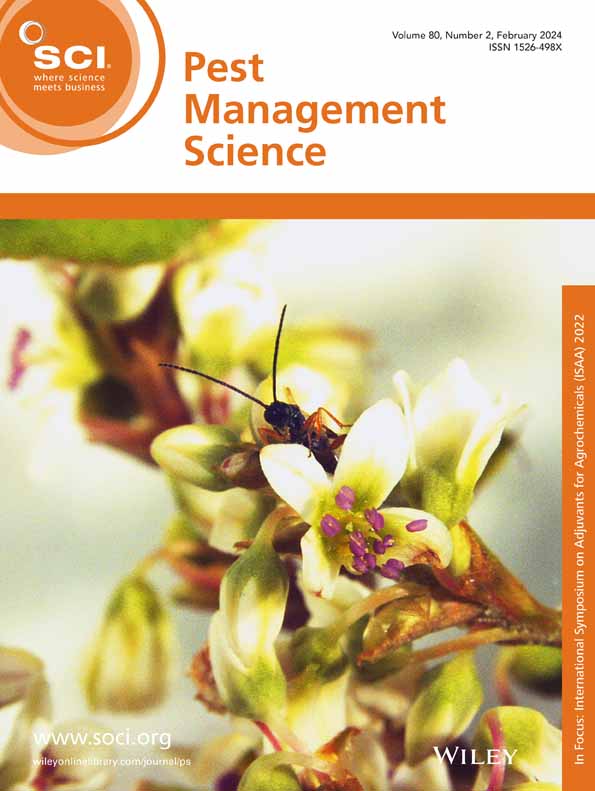草坪草细菌内生菌的生物防治效果评价。
IF 3.8
1区 农林科学
Q1 AGRONOMY
引用次数: 0
摘要
clarireedia spp.是一组具有高度破坏性的植物病原真菌,可影响寒季和暖季草坪草,导致dollar spot (DS)病的发展。生物防治是化学方法的一种很有前途的替代方法,具有环境效益,并消除了杀菌剂耐药性发展的风险。结果从草坪草中分离到2934株具有抑制DS病潜力的内生细菌。43株菌株对杰克逊Clarireedia jacksonii LT586有抑制作用,生长抑制率(gres)为6.52% ~ 87.38%。28株菌株(主要是假单胞菌和芽孢杆菌)的GIR值为bbb50 %,其中11株菌株有效抑制LT586而不引起草皮植物毒性。盆栽试验进一步验证了蜡样芽孢杆菌菌株B694的生防潜力,接种后6 d的抑菌率为92.93%,接种后11 d的抑菌率为88.05%,抑菌效果最高。扫描电镜显示B694在菌丝上形成生物膜,降解菌丝细胞壁,诱导菌丝萎缩。通过对b694处理的杰克逊弧菌LT586的转录组分析,鉴定出1276个差异表达基因(1023个上调;253下调)。代表性上调基因与几丁质和葡聚糖合成、甾醇和脂肪酸代谢、谷胱甘肽代谢、跨膜转运蛋白和细胞色素P450单加氧酶有关。这些研究结果表明,杰克逊氏梭菌试图通过增强细胞壁和细胞膜的合成、激活抗氧化应激反应和解毒细菌抗菌化合物来维持细胞功能。结论本研究为蜡样芽孢杆菌B694在草坪草疫病防治中的应用提供了理论基础。©2025化学工业协会。本文章由计算机程序翻译,如有差异,请以英文原文为准。
Evaluation of bacterial endophytes from turfgrass for effective biocontrol of dollar spot disease.
BACKGROUND
Clarireedia spp. are a group of highly destructive phytopathogenic fungi that affect both cool- and warm-season turfgrasses, leading to the development of dollar spot (DS) disease. Biological control presents a promising alternative to chemical methods, offering environmental benefits and eliminating the risk of fungicide resistance development.
RESULTS
A total of 2934 endophytic bacterial strains isolated from turfgrasses were screened for their potential to suppress DS disease in this study. Forty-three strains demonstrated inhibitory effects against Clarireedia jacksonii isolate LT586, with growth inhibition rates (GIRs) ranging from 6.52% to 87.38%. Twenty-eight strains (primarily Pseudomonas and Bacillus spp.) showed > 50% GIR, and 11 of these strains effectively suppressed LT586 without causing turfgrass phytotoxicity. Pot experiments further validated the biocontrol potential of Bacillus cereus strain B694, which exhibited the highest control efficacy, with 92.93% inhibition at 6 days and 88.05% at 11 days post-inoculation. Scanning electron microscopy revealed that B694 formed biofilms on hyphae, degrading its cell walls and inducing atrophy. Transcriptome analysis of B694-treated C. jacksonii LT586 identified 1276 differentially expressed genes (1023 up-regulated; 253 down-regulated). Representative up-regulated genes were associated with chitin and glucan synthesis, sterol and fatty acid metabolism, glutathione metabolism, transmembrane transporters, and cytochrome P450 monooxygenases. These findings suggest that C. jacksonii attempts to maintain cellular function by enhancing cell wall and membrane synthesis, activating antioxidant stress responses, and detoxifying bacterial antimicrobial compounds.
CONCLUSION
This study provides a theoretical foundation for future investigations into the use of Bacillus cereus B694 as a potential biocontrol agent for DS in turfgrass disease management. © 2025 Society of Chemical Industry.
求助全文
通过发布文献求助,成功后即可免费获取论文全文。
去求助
来源期刊

Pest Management Science
农林科学-昆虫学
CiteScore
7.90
自引率
9.80%
发文量
553
审稿时长
4.8 months
期刊介绍:
Pest Management Science is the international journal of research and development in crop protection and pest control. Since its launch in 1970, the journal has become the premier forum for papers on the discovery, application, and impact on the environment of products and strategies designed for pest management.
Published for SCI by John Wiley & Sons Ltd.
 求助内容:
求助内容: 应助结果提醒方式:
应助结果提醒方式:


